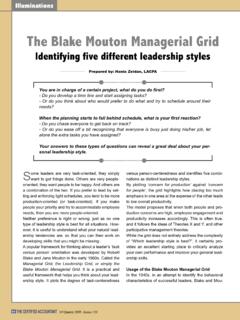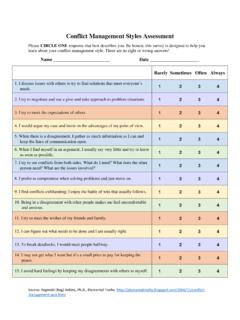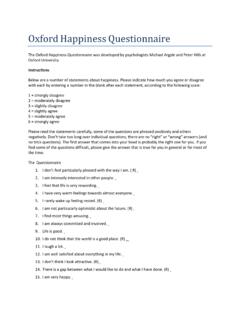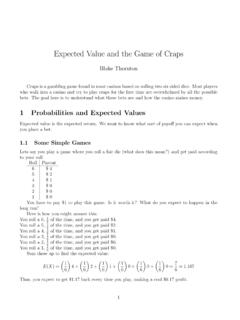Transcription of Ralph E. Blake
1 CHAPTER 2 BASIC VIBRATION THEORYR alph E. BlakeINTRODUCTIONThis chapter presents the theory of free and forced steady-state vibration of singledegree-of-freedom systems. Undamped systems and systems having viscous damp-ing and structural damping are included. Multiple degree-of-freedom systems arediscussed, including the normal-mode theory of linear elastic structures andLagrange s PARTS OF VIBRATORY SYSTEMSV ibratory systems comprise means for storing potential energy (spring), means forstoring kinetic energy (mass or inertia), and means by which the energy is graduallylost (damper). The vibration of a system involves the alternating transfer of energybetween its potential and kinetic forms.
2 In a damped system, some energy is dissi-pated at each cycle of vibration and must be replaced from an external source if asteady vibration is to be maintained. Although a single physical structure may storeboth kinetic and potential energy, and may dissipate energy, this chapter considersonly lumped parameter systemscomposed of ideal springs, masses, and damperswherein each element has only a single function. In translational motion, displace-ments are defined as linear distances; in rotational motion, displacements aredefined as angular the linear spring shown in Fig. , thechange in the length of the spring is proportionalto the force acting along its length:F=k(x u)( )The ideal spring is considered to have no mass;thus, the force acting on one end is equal 09/20/2001 11:37 AM Page to the force acting on the other end.
3 The constant of proportionality kis thespring constant or mass is a rigid body (Fig. ) whoseacceleration xaccording to Newton s second law isproportional to the resultant Fof all forces acting onthe mass:*F=m x( ) the viscous damper shown in Fig. ,the applied force is proportional to the relativevelocity of its connection points:F=c( x u)( )The constant cis the damping coefficient,the charac-teristic parameter of the damper. The ideal damperis considered to have no mass; thus the force at oneend is equal and opposite to the force at the dampingis considered below andseveral other types of damping are considered inChap. MOTIONThe elements of a mechanical system which moves with pure rotation of the partsare wholly analogous to the elements of a system that moves with pure property of a rotational system which stores kinetic energy is inertia; stiffnessand damping coefficients are defined with reference to angular displacement andangular velocity, respectively.
4 The analogous quantities and equations are listed inTable TWOTABLE Quantities in Translational and Rotational Vibrating SystemsTranslational quantityRotational quantityLinear displacement xAngular displacement Force FTorque MSpring constant kSpring constant krDamping constant cDamping constant crMass mMoment of inertia ISpring law F=k(x1 x2)Spring law M=kr( 1 2)Damping law F=c( x1 x2)Damping law M=cr( 1 2)Inertia law F=m xInertia law M=I * It is common to use the word massin a general sense to designate a rigid body. Mathematically, the massof the rigid body is defined by min Eq. ( ).FIGURE 09/20/2001 11:37 AM Page as the mathematical equations for a rotational system can be written byanalogy from the equations for a translational system, only the latter are discussed indetail.
5 Whenever translational systems are discussed, it is understood that correspond-ing equations apply to the analogous rotational system, as indicated in Table DEGREE-OF-FREEDOM SYSTEMThe simplest possible vibratory system is shown in Fig. ; it consists of a mass mattached by means of a spring kto an immovable support. The mass is constrained totranslational motion in the direction of the Xaxis so that its change of position froman initial reference is described fully bythe value of a single quantity thisreason it is called a single degree-of-freedom the mass mis dis-placed from its equilibrium position andthen allowed to vibrate free from furtherexternal forces, it is said to have vibration also may beforced; , a continuing force acts uponthe mass or the foundation experiences acontinuing motion.
6 Free and forcedvibration are discussed VIBRATION WITHOUT DAMPINGC onsidering first the free vibration of the undamped system of Fig. , Newton sequation is written for the mass force m xexerted by the mass on the springis equal and opposite to the force kxapplied by the spring on the mass:m x+kx=0( )where x=0 defines the equilibrium position of the solution of Eq. ( ) isx=Asin t+Bcos t( )where the term k / m is the angular natural frequencydefined by n= rad/sec( )The sinusoidal oscillation of the mass repeats continuously, and the time interval tocomplete one cycle is the period: =( )The reciprocal of the period is the natural frequency:fn== = = ( )kg W1 2 k m1 2 n 2 1 2 nk mk mk mBASIC VIBRATION single degree-of-freedom 09/20/2001 11:37 AM Page W=mgis the weight of the rigid body forming the mass of the system shownin Fig.
7 The relations of Eq. ( ) are shown by the solid lines in Fig. TWOFIGURE frequency relations for a single degree-of-freedom system. Relation ofnatural frequency to weight of supported body and stiffness of spring [Eq. ( )] is shown by solidlines. Relation of natural frequency to static deflection [Eq. ( )] is shown by diagonal-dashedline. Example: To find natural frequency of system with W=100 lb and k=1000 lb/in., enter at W=100 on left ordinate scale; follow the dashed line horizontally to solid line k=1000, then ver-tically down to diagonal-dashed line, and finally horizontally to read fn=10 Hz from right ordi-nate Eq. ( ),Bis the value of xat time t=0, and the value of Ais equal to x/ nat time t=0.
8 Thus, the conditions of displacement and velocity whichexist at zero time determine the subsequent oscillation ( ) for the displacement in oscillatory motion can bewritten, introducing the frequency relation of Eq. ( ),x=Asin nt+Bcos nt=Csin ( nt+ )( )where C=(A2+B2)1/2and =tan 1(B/A). The angle is called the phase static deflection of a simple mass-spring system is thedeflection of spring kas a result of the gravity force of the mass, st=mg/k.(Forexample, the system of Fig. would be oriented with the mass mvertically abovethe spring k.) Substituting this relation in Eq. ( ),fn= ( )g st1 2 09/20/2001 11:37 AM Page relation of Eq. ( ) is shown by the diagonal-dashed line in Fig.
9 This rela-tion applies only when the system under consideration is both linear and elastic. Forexample, rubber springs tend to be nonlinear or exhibit a dynamic stiffness whichdiffers from the static stiffness; hence, Eq. ( ) is not VIBRATION WITH VISCOUS DAMPINGF igure shows a single degree-of-freedom system with a viscous damper. The dif-ferential equation of motion of mass m,corresponding to Eq. ( ) for theundamped system, ism x+c x+kx=0( )The form of the solution of this equa-tion depends upon whether the damp-ing coefficient is equal to, greater than,or less than the critical damping coeffi-cient cc:cc=2 k m =2m n( )The ratio =c/ccis defined as the frac-tion of critical the damping of the system is less than critical, <1; then the solution of Eq.
10 ( ) isx=e ct/2m(Asin dt+Bcos dt)=Ce ct/2msin ( dt+ )( )where Cand are defined with reference to Eq. ( ). The damped natural frequencyis related to the undamped natural frequency of Eq. ( ) by the equation d= n(1 2)1/2rad/sec( )Equation ( ), relating the dampedand undamped natural frequencies, isplotted in Fig. c=cc, thereis no oscillation and the solution of Eq.( ) isx=(A+Bt)e ct/2m( )Greater-Than-Critical >1, the solution of Eq. ( ) isx=e ct/2m(Ae n 2 1 t+Be n 2 1 t)( )This is a nonoscillatory motion; if thesystem is displaced from its equilibriumposition, it tends to return VIBRATION degree-of-freedom systemwith viscous natural frequency as afunction of undamped natural frequency andfraction of critical 09/20/2001 11:37 AM Page degree of damping in a system having <1 may bedefined in terms of successive peak values in a record of a free oscillation.







